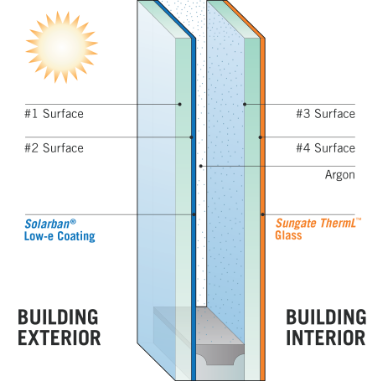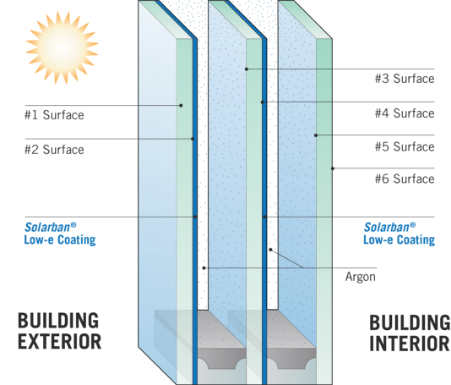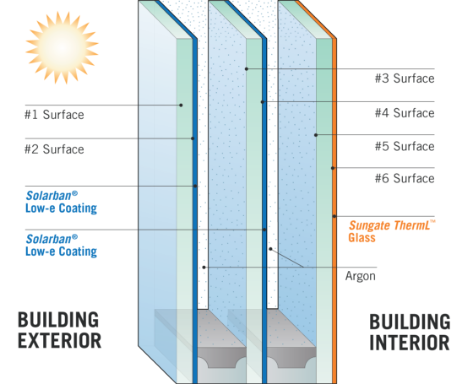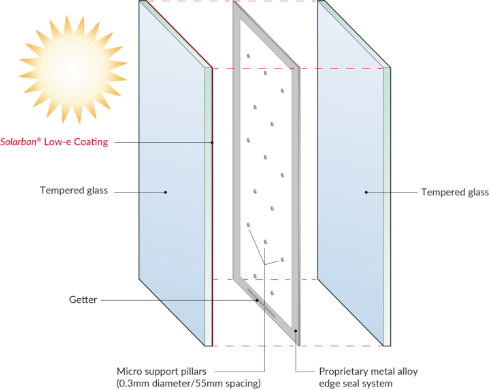U need improved thermal performance. Vitro has options.
When it comes to thermal performance, U won’t believe how many choices Vitro Architectural Glass offers to improve U-values. Thanks to advances in low-emissivity (low-e) technology, architects have more options than ever to lower U-values and improve R-values wherever increased thermal performance is needed. In fact, with Solarban® double-silver, triple-silver and even quad-silver solar control, low-e coatings from Vitro available for use in double and triple pane insulating glass units (IGUs), improved R- and U-values are easier than ever to achieve.
Now, new Vitro products, like Sungate ThermL™ low-e coating and VacuMax™ Vacuum Insulating Glass (VIG) allow for even better R- and U-values than ever before.
Sungate ThermL™ U-Value Enhancing Low-e Glass
Specifically engineered for use on the interior surface of an IGU, Sungate ThermL™ low-e coating is designed to retain indoor temperatures by slowing down heat transfer through the IGU while allowing for a high rate of visible light transmittance (VLT). This results in up to a 21% improvement in the U-value over using a single solar control low-e glass alone.
VacuMax™ Vacuum Insulating Glass
With VacuMax™ Vacuum Insulating Glass (VIG), thermal performance more than triples. VacuMax™ VIG combines vacuum technology with Solarban® 70 low-e glass in an IGU that is just 8.3mm thick to provide exceptional thermal performance that rivals the performance of traditional walls. The unit’s slim construction and light weight allows it to be incorporated into virtually any traditional glazing system, window frame or curtainwall application. With R-values up to R20, VacuMax™ VIG units can deliver thermal performance that is 5 times better than conventional insulating glass and up to 20 times better than monolithic glass.
Performance
See how these sample configurations can help you achieve real R- and U-value improvements.
Note: Measurement of improved U-values are calculated using a baseline of a Double Low-e 1” IGU Solarban® 70 (2) Clear + Clear 1” with argon from Vitro Architectural Glass, with a U-value of 0.24.
Level One: Dual Coating Double IGU
Solarban® 70 (2) Clear + Sungate ThermL™ (4) Clear 1” IGU w/ Argon
U-Value: 0.19, a 21% improvement
R-Value: 5.26, a 26% improvement

Level Two: Dual Coating Triple IGU
Solarban® 70 (2) + Solarban® 60 (4) Clear Glass IGU w/ Argon
U-Value: 0.12, a 50% improvement
R-Value: 8.33, a 100% improvement

Level Three: Triple Coating Triple IGU
Solarban® 70 (2) + Solarban® 60 (4) + Sungate ThermL™ (6) Clear Glass IGU w/ Argon
U-Value: 0.11, a 54% improvement
R-Value: 9.09, a 118% improvement

Level Four: Vacuum Insulating Glass
VacuMax™ with Solarban® 70 (2)
U-Value: 0.05, a 79% improvement
R-Value: Up to R20, a 380% improvement

Get samples U can see for yourself.
Vitro has manufactured the industry’s favorite low-emissivity glass for nearly two decades. If you’d like to see the quality for yourself, you can request free samples of Solarban® 70 glass, VacuMax™ VIG, Sungate ThermL™ glass and more low-e products at samples.vitroglazings.com.
You can also use Vitro’s new GlassFinder™ tool to compare products by a range of performance metrics, including U‑value, as well as aesthetics to identify the best glass to meet the needs of your next project.
To compare the energy efficiency and carbon impact of Vitro’s glass products, try the new Vitro emissions™ Calculator, which models energy consumption as well as embodied and operational carbon emissions in a range of standard building types.


